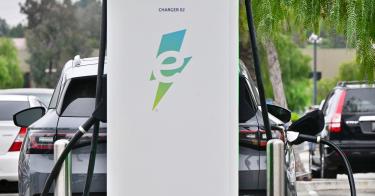President Biden’s latest push for electric vehicles, or EVs, is reminiscent of a soliloquy by Don Quixote: short on facts, long on rhetoric, and filled with unrealistic expectations. Sadly, though, Mr. Biden’s policy mistakes are moving beyond fiction to a reality that confines consumers to cars that are unaffordable and unwanted.
Like Don Quixote tilting at harmless windmills he thinks are giants, Mr. Biden is attacking American energy and the auto industry for daring to use fossil fuels. And as Don Quixote went from quest to quest attempting to free imaginary prisoners, Mr. Biden is hellbent on freeing Americans from the imaginary captivity of their reliable, safe, flexible and economical gasoline- and diesel-fueled engines.
That disconnect from reality perfectly encapsulates Mr. Biden’s energy policy. His Environmental Protection Agency recently proposed such strict regulations for cars and trucks that effectively mean that 54% of new vehicles sold domestically must be EVs by 2030.
Even if Mr. Biden managed a 500% increase in EV sales by the end of the decade, he’d still fall woefully short of his goal. The only conceivable way to make half of new vehicle sales EVs by 2030 would be if Americans were so poor that they could afford very few new cars, and thus the small number of EVs could still amount to half of all new vehicles. That’s right out of Mao’s Great Leap Forward.
>>> Emissions-free Electric Vehicles Are a Fantasy
Just from the standpoint of raw materials, Mr. Biden’s EV goal is fictitious. We simply cannot get the needed materials in sufficient volume in time. Furthermore, the schizophrenic energy policy of this administration is simultaneously ramping up demand for those raw materials while hamstringing the supply. Mr. Biden continues blocking mining of lithium, graphite, nickel and rare earth metals.
That’s inexplicable, since Mr. Biden’s green energy transition would increase demand for those materials by 4,200%, 2,500%, 1,900% and 700%, respectively, in less than 20 years.
But when you consider that “it has taken on average over 16 years to move mining projects from discovery to first production,” then Biden’s proposals aren’t unachievable—they’re laughable.
And from where does Mr. Biden think the electricity to power these EVs will come? The strained electrical grid already has brownouts and blackouts in parts of the country and couldn’t handle millions more EVs, especially when Mr. Biden is also blocking copper mining, the main ingredient in electrical wires.
The grid’s transmission capacity would need to grow 60% in less than seven years and grow 200% in less than 30 years. And this is just the grid infrastructure, not what would be needed to power it.
The Biden administration repeatedly refers to EVs as zero-emission vehicles, as if the electricity powering them did not have emissions. EVs are powered primarily by fossil fuels, not just because fossil fuels generate much of our electricity but because they are dispatchable, meaning their electrical output can be ramped up and down in response to demand.
Conversely, wind and solar generate electricity only when conditions are right, regardless of demand, and nuclear power needs to stay at a very steady output to be efficient. That leaves coal and natural gas (and oil on rare occasions) to be the real workhorses of electrical generation. When everyone needs to cool their homes and offices at the same time, or charge their EVs, coal and natural gas throttle up.
Mr. Biden’s plan merely shifts emissions from one location to another. Instead of carbon dioxide leaving a tailpipe, it will leave a smokestack. Either climate change isn’t a global problem, or the president is taking the saying “out of sight, out of mind” too literally.
Worse, America is dependent on countries such as China when it comes to EVs, and those countries will receive a windfall under Mr. Biden’s centrally planned industrial policy.
>>> The Case Against Electric Vehicles
China will soon control about one-third of the world’s lithium supply, a critical component for EVs. Meanwhile, these essential resources, when mined overseas, are regularly done so by slave and child labor, and the International Energy Agency has admitted that the environmental damage from mining overseas could offset the reduced emissions from operating EVs domestically.
Even more ironic, Mr. Biden again pitched EVs as “affordable” and renewed his commitment to providing EV charging stations in low-income communities. The average EV costs $61,000, which is 24% more than the average conventional internal combustion engine vehicle—hardly “affordable.”
Charging stations are useless for Americans who can’t afford EVs. That’s like giving batteries to a child who has no toys in which to use them. The average American family has effectively lost $7,100 in purchasing power under Mr. Biden; people don’t need to pay more for a vehicle that can’t drive as far.
The incoherence of Mr. Biden’s energy policy knows no bounds. Hopefully, these policies will meet a speedy end the same way their equally fantastical predecessor, Don Quixote, did.
This piece originally appeared in The Washington Times




